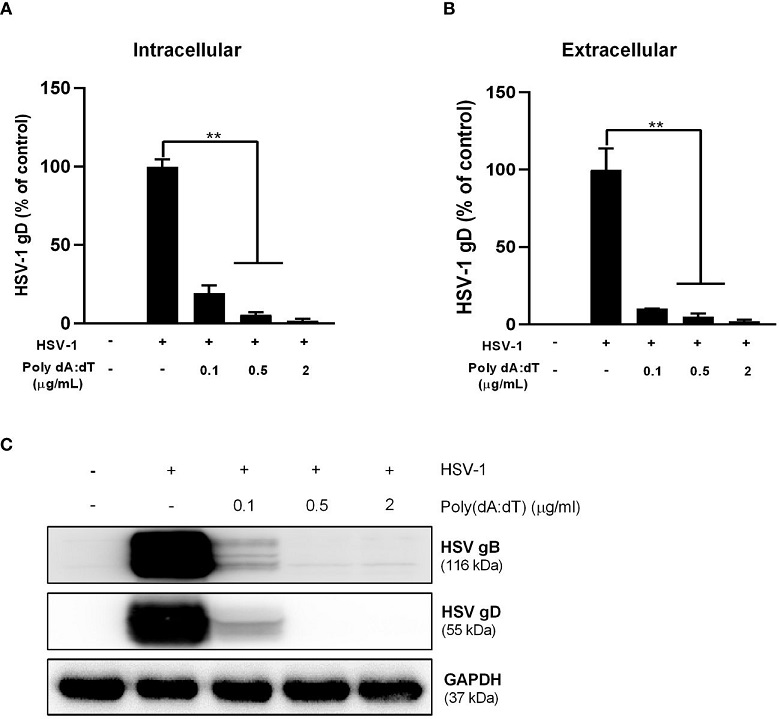Nikhil Prasad Fact checked by:Thailand Medical News Team May 18, 2024 1 year, 7 months, 1 week, 6 hours, 23 minutes ago
Medical News: Astrocytes, the star-shaped glial cells in the brain and spinal cord, play a crucial role in the central nervous system (CNS) innate immunity. Among the various pathogens that can invade the CNS, Herpes Simplex Virus Type 1 (HSV-1) is particularly notorious. This virus not only infects astrocytes but also relies on them for replication and dissemination. Understanding how astrocytes combat HSV-1 infection is essential for developing new therapeutic strategies.
Researchers from Temple University Lewis Katz School of Medicine in the USA and Wuhan University of Science and Technology in China have delved into this intricate interplay. Their study covered in this
Medical News report explores how the activation of cytosolic DNA sensors in human astrocytes can inhibit HSV-1 through the induction of interferon regulatory factor 1 (IRF1).
 Poly(dA:dT) inhibits HSV-1 DNA replication. U373 cells were pretreated with poly(dA:dT) for 24h and followed by HSV-1 (MOI of 0.02) infection for 2h. The cells were then washed with PBS. Twenty-four hours post infection (PI), intracellular (A) and extracellular (B) DNA were collected and analyzed by the real-time PCR for HSV-1 gD expression. (C) Total cellular proteins were extracted and analyzed by Western blot for HSV-1 gD and gB protein expression. Data shown in (A, B) were the mean ± SD of three independent experiments with triplicate wells (**P < 0.01).
Poly(dA:dT) inhibits HSV-1 DNA replication. U373 cells were pretreated with poly(dA:dT) for 24h and followed by HSV-1 (MOI of 0.02) infection for 2h. The cells were then washed with PBS. Twenty-four hours post infection (PI), intracellular (A) and extracellular (B) DNA were collected and analyzed by the real-time PCR for HSV-1 gD expression. (C) Total cellular proteins were extracted and analyzed by Western blot for HSV-1 gD and gB protein expression. Data shown in (A, B) were the mean ± SD of three independent experiments with triplicate wells (**P < 0.01).
Methods: Decoding the Astrocyte's Defense Mechanism
To uncover the mechanisms by which astrocytes defend against HSV-1, the researchers employed both primary human astrocytes and a human astrocyte cell line (U373). They utilized techniques such as reverse transcription quantitative PCR (RT-qPCR) and Western blot assays to measure interferons (IFNs), antiviral IFN-stimulated genes (ISGs), IFN regulatory factors (IRFs), and HSV-1 DNA. Additionally, they used CRISPR/Cas9 and siRNA transfection techniques to knock out or knock down IRF1.
Results: Poly(dA:dT) and Its Antiviral Effects
-Poly(dA:dT) Inhibits HSV-1 Replication
The study found that poly(dA:dT), a synthetic analog of double-stranded DNA, significantly inhibited HSV-1 replication in human astrocytes. When U373 cells were pretreated with poly(dA:dT) for 24 hours before HSV-1 infection, the levels of intracellular and extracellular HSV-1 gD DNA were much lower compared to untreated cells. This inhibitory effect was dose-dependent, meaning higher doses of poly(dA:dT) led to greater suppression of the virus.
-Induction of DNA and RNA Sensors
Astrocytes are equipped with various pattern recognition receptors (PRRs) that detect viral components and trigger immune responses. The researchers found that poly(dA:dT) treatment increased the expression of several key RNA sensors (MDA5, TLR3, and RIG-I) and DNA sensors (IFI16 and ZBP1) in both primary human astrocytes and U373 cells. This upregulation indicates that poly(dA:dT) activates multip
le pathways involved in recognizing and responding to viral infections.
-Induction of Interferons and IFN-Stimulated Genes
Interferons play a pivotal role in the antiviral response by inducing a wide range of ISGs. Poly(dA:dT) treatment led to significantly higher expression of IFN-β and type III interferons (IFN-λ1 and IFN-λ2/3) at both mRNA and protein levels in astrocytes. Additionally, the study observed a dose-dependent increase in the expression of ISGs such as MxA, ISG56, and Viperin, which are known to inhibit viral replication.
-The Role of IRF1 in the Antiviral Response
Among the interferon regulatory factors, IRF1 stood out as a key player in the poly(dA:dT)-induced antiviral response. The researchers found that poly(dA:dT) selectively induced the expression of IRF1, IRF7, and IRF9 in astrocytes, with IRF1 showing the earliest and highest increase. Further experiments revealed that knocking down or knocking out IRF1 significantly diminished the induction of ISGs and IFNs by poly(dA:dT), highlighting IRF1's crucial role in mediating the antiviral effects.
Astrocytes as Key Players in CNS Immunity
This study reinforces the idea that astrocytes are not just passive targets for HSV-1 but active participants in the CNS's innate immune response. By activating DNA sensors and inducing IRF1, astrocytes can mount a robust antiviral defense that limits HSV-1 replication.
Potential Therapeutic Applications
The findings suggest that targeting DNA sensors in astrocytes could be a promising strategy for developing immune-based therapies against HSV-1. Since this approach enhances the production of multiple antiviral factors within infected cells, it reduces the likelihood of the virus developing resistance.
Future Directions
While the in vitro results are promising, further research is needed to confirm these findings in vivo. Studies involving animal models and clinical specimens will be crucial for developing and validating DNA sensor activation-based therapies for HSV-1 infections in the CNS.
Conclusion: Harnessing the Power of DNA Sensors for Antiviral Defense
In summary, the activation of cytosolic DNA sensors in human astrocytes triggers a potent antiviral response against HSV-1 through the induction of IRF1. This discovery opens new avenues for therapeutic interventions that harness the innate immune system to combat viral infections in the CNS. As researchers continue to explore the intricate mechanisms of astrocyte-mediated immunity, the potential for developing innovative treatments for HSV-1 and other neurotropic viruses looks increasingly promising.
The study findings were published in the peer reviewed journal: Frontiers in Cellular and Infection Microbiology.
https://www.frontiersin.org/articles/10.3389/fcimb.2024.1383811/full
For more about Herpes, keep on logging to Thailand
Medical News.
